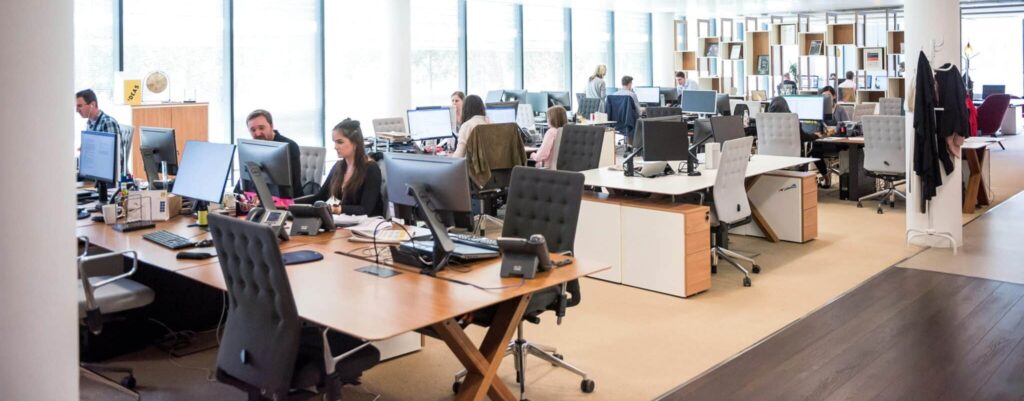Employee centric culture: 8 steps to a people-centered workplace

Everyone benefits from an employee centric culture.
When companies foster a positive culture, they’re also laying the groundwork for higher productivity and profits, along with lower turnover rates and unnecessary human resources expenses.
And of course, working to improve employee experience makes for happier and healthier workers, too.
Creating a people-centered workplace starts with understanding what employees need—and then taking the necessary steps to get there. In this article, we cover eight best practices for creating a more employee centric workplace. These best practices even work with a remote or distributed workforce. We’ll also explore why an employee centric culture is so critical to business success.
What is an employee centric workplace?
An employee centric workplace is just what it sounds like. It’s one that highly values its employees, and works to create an enjoyable and meaningful workplace experience for them.
An employee centric culture stems from companies putting their people first, trusting that productivity and profits will follow.
Most company leaders understand that happy employees are key to long term success. Like organizational consultant Simon Sinek famously declared, “happy employees ensure happy customers. And happy customers ensure happy shareholders—in that order.”
As we’ll explore below, the many benefits of fostering this type of employee centric company culture make them especially critical in a post-pandemic, post-Great Resignation world.
Ultimately, smart companies today understand that focusing efforts on building a more employee-centric organization is as critical (if not more so) as any other workplace strategy they can embrace. Focusing on improving your employee experience index is as much a growth strategy as it is anything else.
A concept originally heralded by HR, today’s facility managers (FMs) now also have to contend with employee centricity. FM responsibilities increasingly include optimizing both the return to the office and the real estate portfolio.
The reality is that as we move into a new age of hybrid and flexible working, all parties are going to have to work together to maintain and build that connected, people-first culture.
As OfficeSpace CEO David Cocchiara said in a recent online all-hands meeting, “we’re all responsible for the culture.”
As a side note, digital all-hands meetings are one of the many best practices for maintaining camaraderie and culture among a distributed workforce. We’ll cover more such best practices to improve both the hybrid workplace and the employee experience further below.
“A paycheck is usually enough to get most people to work on time, but only an inspiring purpose beyond a paycheck will encourage people to go the extra mile.”
Carmine Gallo, Forbes
Some examples of employee centric companies
Many of today’s top companies are taking steps to create a people-first culture—and seeing positive results from their efforts.
For example, after Ruby Receptionists increased their hourly minimum pay and provided unique perks, they nearly doubled their staff. And they raised $38.8 million in private equity in one year alone.
Plus, a variety of employee activities like galas, onsite fitness classes, and movie nights has helped create an environment where 94% of employees feel the company is a ‘fun place to work.’
Meanwhile, 98% of Atlassian’s employees report that they feel proud to tell people where they work. And that they believe they can count on their leaders to act with integrity. The company offers a wide range of benefits, including parental leave and support and flexible working arrangements. And to top it off, they boast an ‘open company, no bull****’ policy. So it should come as no surprise they were able to grow their staff by 80% in one year. Or to file an estimated $3.3 billion IPO just 13 years after their founding.
OfficeSpace client Hubspot also consistently ranks among the companies with the highest employee satisfaction levels on platforms like Glassdoor and Great Place to Work. This is thanks in large part to their famous Culture Code. It touts values like ‘great people want direction on where they’re going—not directions on how to get there.’ And having a ‘no door’ policy where ‘everyone has access to anyone in the company.’
Like we’ll explore below, as part of their commitment to people, Hubspot has also created a physical workspace that is driven by employee needs. This further adds to their positive culture.

Why is an employee centric culture important?
Deloitte research shows that 85% of executives and 84% of team members think having engaged and motivated employees is a ‘top factor’ contributing to a company’s success.
Moreover, a whopping 94% of leaders, along with 88% of employees, think distinct workplace
culture is important.
This helps explain why Peter Drucker famously maintains that “culture eats strategy for breakfast.”
Consider the fact that one survey found that about 30% of employees would be willing to quit for a more empathetic company. 40% would even work longer hours for such a company.
Plus, according to Great Place to Work research, voluntary turnover at companies that value employee happiness are just 8%. This is a big difference compared to the 21% national average.
Benefits of an employee centric workplace
Specifically, fostering an employee-centric culture brings a host of benefits, including:
- Better employer branding to assist with talent attraction efforts
- Happier employees to assist with talent retention efforts
- Increased productivity
- More innovation in the workplace
- More empowerment in the workplace
Of course, business metrics, end goals, and balance sheets all matter.
But at the end of the day, employees are the heart of any organization. So improving their work experience is at the heart of improving business performance, too.
“If you feel you don’t belong, it creates a sense of insecurity and doubt,” says Tony Bond, chief diversity and innovation officer at Great Place to Work. “And belonging strongly correlates to motivation, productivity, behavior, and happiness.”
Finally, new research shows that only 20% of employees are currently engaged at work—a number that’s lower than it was pre-pandemic. Clearly, hybrid leadership has some work to do.
“The value of an engaged and effective company culture can’t be overstated, especially in today’s competitive recruiting environment.”
Tim Johnson, Mondo, writing in Forbes

How to create employee focused culture: 8 best practices
When employee experience is a core value, productivity will increase, likely leading to cost savings and higher revenue.
But as more and more companies embrace flexible and distributed work, maintaining that core culture will be challenging.
Thankfully, the following best practices can help every company today create a more positive and flexible work culture.
1. Understand employee needs
The simplest way to improve employee engagement is to go to the source: the employees themselves.
Never assume that employees are happy or that they have what they need to be productive.
Instead, business leaders should be conducting regular employee surveys and pulse checks to see what’s working for employees. And, critically, what’s not working, too.
“I want to act with employees’ best interest in mind, and what better way to do that than to ask them directly?” says OfficeSpace Senior People Operations Manager Taylor Graves.
This should include exit interviews. These can help HR and the company overall understand where there may be opportunities to increase employee satisfaction and retention.
That said, employees aren’t always the best judges of what they actually want or need.
For example, anyone navigating a return to the office will likely discover quickly that employees aren’t great at predicting when they’ll actually be in the office.
That’s why companies should supplement any surveys with hard data, in the form of advanced workplace analytics. Getting accurate, real-time data of how employees are using the office and their resources is one of the best ways to truly understand the complete picture of their needs.
2. Offer flexible work options
Given current demands for flexible work options, offering more flexibility isn’t really just an incentive anymore—it’s a necessity.
Specifically, 80% of knowledge workers today want flexibility in where they work. While a whopping 94% want flexibility in when they work.
And—worryingly for anyone trying to stay competitive—the latest research shows that 70% of employees are dissatisfied with their current level of work flexibility.
Of course, complete freedom won’t be possible in every work environment.
But leaders should use their analytics and survey data to determine if they can adopt any of the many hybrid work models now available. Just because you can’t adopt something as dramatic as agile working, for example, doesn’t mean that exploring options like working neighborhoods or office hoteling wouldn’t be beneficial.
3. Embrace equity and inclusion
Creating a more inclusive company culture should always be a top priority for business leaders.
This carries its own intrinsic value, of course.
Research also shows that companies that support women, front-line workers, hourly male workers, long-tenured employees, and employees of color outperform their competition. And moreover, can see stock market gains even during times of recession.
Employees are a company’s biggest asset. Deeply engaged, they can deliver 20 percent higher profitability for an organization through greater productivity.
Brook Potter & Andrew Yu, FMJ Magazine
4. Promote health and wellness
Healthy employees are also happy employees, so workplace wellbeing should always be a priority.
Creating ample health and wellness benefits also signals to employees that their employer cares about them beyond their professional lives alone. Ensuring everyone has access to quality care can also help improve equity efforts.
At the very least, employers should provide robust medical and extended benefits.
Many are also exploring options like gym stipends, health spending accounts, providing healthy lunches, and reimbursing employees for traveling to work in a sustainable and/or healthy way (i.e.: walking and biking).
A flexible schedule that allows employees to go to health appointments without restrictions goes a long way here, too.
5. Provide the right technology
Employees need the right technology to do their work. But the rise in hybrid work can certainly make this more challenging.
For example, despite the popularity of hybrid work today, current research shows that 70% of workers are still frustrated with technology in hybrid meetings. And, not surprisingly, 71% find these meetings stressful.
FMs will therefore need to work with IT to ensure that employees have the right hybrid workplace technology in the following key areas:
- The right hardware (i.e.: a laptop to take back and forth, as well as good audio-visual tools for meetings)
- The right software (i.e.: a digital workspace that provides everything they need to do their jobs well and collaborate, from anywhere)
- The right technology to interact with the workplace (i.e: good wayfinding, as well as desk and room booking software and centralized request management)
Note that some of the biggest challenges of hybrid working have to do with cyber security issues. So FMs should also work with IT to ensure that good security measures are in place and well understood by all employees. This may also include shoring up security in their building automation systems.
Finally, it’s critical to note that only 46% of companies are currently helping employees with their remote work expenses. This presents an opportunity for smart companies to provide stipends and support. This is to ensure everyone on the team has access to a good internet connection and healthy working environment, no matter where they’re logging in for the day.
6. Provide the right spaces
The following clip discusses the importance of having the right space:
Part of what makes Hubspot so successful regarding employee experience is their commitment to creating the right physical environment for their in-office teams.
“In order to design the office as a social anchor, we need to create spaces that facilitate serendipitous connections and team collaboration. This includes open nomad tables, lounge areas with digital whiteboards, and booths to grab coffee or share meals” says Kate Bueker, Chief Financial Officer for the company.
To provide the right spaces in this way, companies (and FMs) need to take the surveys and workplace data they’ve collected. They must use the insights they provide to create the best combination of heads-down and collaborative workspaces for their teams.
As we move away from traditional, 9-to-5 offices with completely assigned desks, this becomes increasingly challenging—and increasingly important, too.
“The dimensions of how people are using the office have changed dramatically,” says Kathleen Williams, Senior Product Manager at OfficeSpace. “And without advanced workplace analytics tools, people won’t have a good idea of how to see what’s actually happening in their workplace, which is where data analytics comes in.”
For many companies, using data to create better spaces will ultimately require a workplace transformation. They’ll need to move to adopt work environment types that are more flexible and, ideally, more productive. For example, activity-based working, agile working, hot desking, and office neighborhoods can all be implemented to make a better workplace.
“The challenge is finding ways to make the in-office experience valuable for employees and keeping things within a reasonable budget, while also giving people freedom to live and work where they want,” says Graves. “We want to make the office experience appealing for employees to come in when they want to, but we also don’t want to pressure anyone to come in if they don’t want to.”
Note that employees will need the aforementioned desk and room booking tools to be able to access these spaces. They will also need new guidelines and assistance to ensure they know how best to use the new spaces available.
The office continues to play an important role—for hybrid meetings, in-person connection, and for those who do their best work in that setting.
Kate Bueker, Chief Financial Officer, HubSpot
7. Offer development opportunities
Part of creating a better workplace culture involves helping employees become the best versions of themselves. Employees need educational opportunities to improve and advance within the company and their professional lives overall.
“Effective executives should view their role as an opportunity to serve employees by helping them grow and learn while providing the support they need in what’s known as a humble or servant leadership style, says Tim Johnson, CEO of Mondo, writing in Forbes. “And it’s much easier to adopt and implement than you might think.”
Leadership should also work with HR to create a career laddering system and/or performance reviews that provide employees with a future within the company or in their careers

8. Embrace people centric initiatives
As much as possible, companies should make conscious efforts to keep their people connected and engaged.
“There’s something beautiful about having a team who have a lot of shared experiences that they’ve built over the course of multiple years working together,” says Graves.”And if you’re spending time with your teammates in person, you might end up valuing those relationships more and be less inclined to leave them for seemingly greener pastures.”
As the Microsoft Work Trend Index 2022 makes clear, “the best leaders will create a culture that embraces flexibility and prioritizes employee wellbeing—understanding that this is a competitive advantage to build a thriving organization and drive long-term growth.”
For many companies, making this type of company culture in a hybrid environment will require a mindset shift. When everyone’s not in the office, leaders will need to bring the office to everyone, virtually. This often means things like virtual game times and happy hours, digital all-hands meetings, and mailing gifts to people who can’t physically make it to the holiday office party.
Communication will also play a key role when it comes to maintaining culture in hybrid offices.
“While it can be tiring to be on Zoom calls all the time, it’s important to have that visibility with the team,” Graves says. It’s also a good idea for people to keep their cameras on, so that fellow participants aren’t just looking at a black screen.
Last but not least, considering that 79% of employees who quit do so because of their perceived ‘lack of appreciation’. Never underestimate the power of a simple pat on the back.
The following clip discusses understanding the purpose of the office:
Employee Culture FAQS
What is the difference between people-centric and employee-centric culture?
The terms ‘people-centric’ and ‘employee-centric’ are both used interchangeably to describe the same thing: a workplace culture that centers around helping employees stay engaged, connected, happy, and healthy.
How can you use employee-centric culture to foster innovation?
An employee-centric culture creates a workspace where employees feel safe and supported. This, along with embracing people-centric workplace strategies that allow for better collaboration, is one of the best ways to foster innovation.
How do you keep employee centric culture alive?
Two things are critical to keeping an employee centric culture alive. First, you should routinely check-in with your employees, allowing them to freely speak their minds about what might need improvement. Second, you should collect data surrounding how people are interacting with their spaces, their resources, and each other. This will help to better understand where there may be gaps that need to be filled.
What is the cost of not having an employee-centric culture?
Given current employee demands for flexibility, the cost of not having an employee-centric culture has never been higher. If you don’t have happy, engaged employees, you can expect to lose them pretty quickly. You may also struggle with employee branding and talent attraction efforts if your culture is lacking.
OfficeSpace provides tools to support companies as they move towards a more employee centric workplace. Reach out for a free demo.
Photos: SolStock, Charday Penn, SDI Productions, courtneyk




